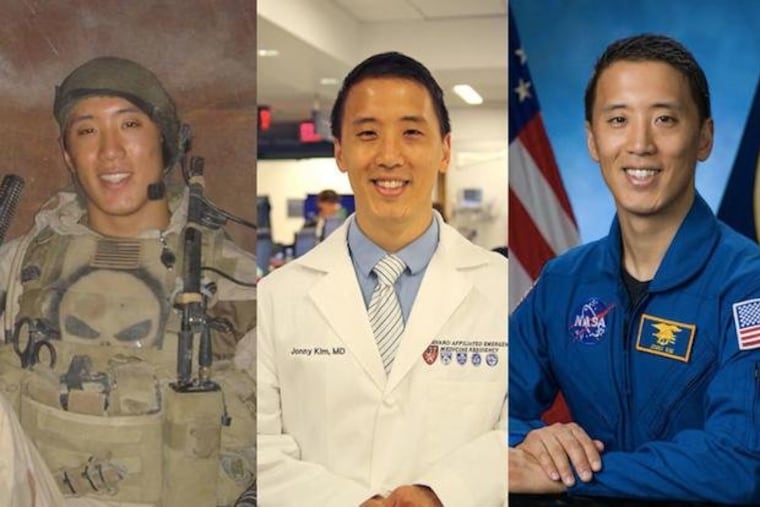The sky is no limit for this Navy SEAL, doctor, and — now — astronaut
“I mean, he can kill you and then bring you back to life. And do it all in space.” He was already a Silver Star-awarded Navy SEAL and Harvard-educated doctor. Now the 35-year-old California native can add another title to his résumé: NASA astronaut.

Jonny Kim was already a Silver Star-awarded Navy SEAL and Harvard-educated doctor. Now the 35-year-old California native can add another title to his résumé: NASA astronaut.
Kim was among 13 men and women to graduate this month from the agency’s Artemis program, making him eligible for missions to the International Space Station, the moon and, ultimately, Mars. Even on a stage of people brimming with talent, he stood out.
“Jonny, you’re a Navy SEAL with a degree from Harvard Medical School,” Sen. Ted Cruz (R., Texas) said during the graduation ceremony at the Johnson Space Center. “That’s just ridiculous! I mean, he can kill you and then bring you back to life. And do it all in space.”
Or, as a headline at Task & Purpose put it: “SEAL, Doctor, Astronaut — Navy Lt. Jonny Kim achieves your childhood dreams so you don’t have to.”
Kim is a first-generation Korean American, born in Los Angeles to parents who immigrated to the United States from South Korea in search of a better future for their children. Despite the accomplishments to come, he struggled with insecurity growing up, according to a 2017 profile in the Harvard Gazette.
» READ MORE: Girls High grad is promoted to colonel in U.S. Army
He had a hard time at school and, as his graduation from Santa Monica High approached in spring 2002, decided that only a bold move could turn things around. So he enlisted in the Navy as a seaman. He asked a recruiter if he could become a member of one of the SEAL teams and was promised only that he could try. Just the opportunity was enough, the Gazette reported.
“I didn’t like the person I was growing up to become,” Kim told the newspaper. “I needed to find myself and my identity. And for me, getting out of my comfort zone, getting away from the people I grew up with, and finding adventure, that was my odyssey, and it was the best decision I ever made.”
The grueling SEAL training process provoked new doubts in him. He thought about quitting during “hell week,” a period of almost nonstop training that all candidates are required to complete.
Instead, he made the cut for the elite team and went on to serve as combat medic, sniper, navigator, and point man on more than 100 combat operations over two deployments to the Middle East, according to NASA. He was awarded a Silver Star and a Bronze Star along the way.
It was during his time in Iraq that Kim decided he wanted to become a doctor. He was serving as a medic one day in 2006 when two of his close friends were shot, the Gazette reported. Kim treated one of them, who had a severe wound to his face. Neither would survive.
“It was one of the worst feelings of helplessness,” Kim said, according to the paper. “There wasn’t much I could do, just make sure his bleeding wasn’t obstructing his airway, making sure he was positioned well. He needed a surgeon. He needed a physician and I did eventually get him to one, but … that feeling of helplessness was very profound for me.”
He earned a degree in mathematics from the University of San Diego in 2012 and his doctorate in medicine from Harvard in 2016. He was a year into a residency at Massachusetts General Hospital when he learned that he had been selected out of a pool of 18,000 applicants to become a NASA astronaut.
The call came while he was grocery shopping.
“I think my heart was racing 100 beats a second, and I tried not to lose my composure in the middle of the grocery store,” Kim said in a video released by NASA. “But once I got the news and I hung up, I ran over to my wife, and I was jumping up and down and telling her that we got in.”
His class included 11 NASA candidates and two Canadian Space Agency candidates. They completed two years of training, including spacewalking, robotics, International Space Station systems, and Russian, to become eligible for spaceflight.
The Artemis program has a goal of sending the first woman and next man to the moon by 2024 and to use what’s learned there to make it to Mars.
“These astronauts could one day in fact walk on the moon as part of the Artemis program,” NASA administrator Jim Bridenstine said during the graduation. “and perhaps one of them could be among the first humans to walk on Mars.”
During the ceremony, the graduates took questions from students in the audience. Asked by an eighth-grade boy whether they had ever experienced self-doubt, Kim took the microphone. He said it is “very human to doubt yourself.”
“Everyone in this audience, everyone watching, is capable of so much more than they think they are,” he said.